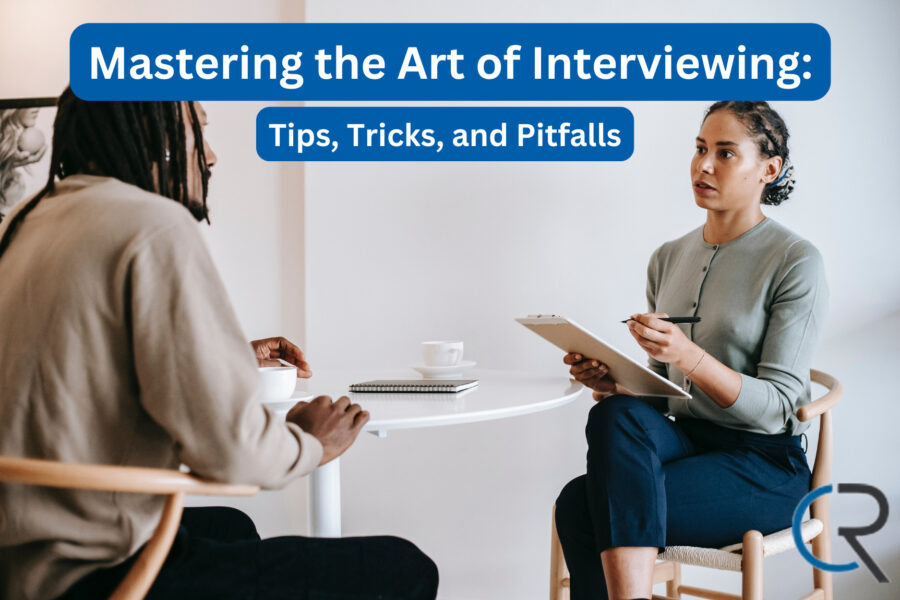Employees are a company’s most valuable asset regardless of the industry.
Hiring requires a thorough process, with interviewing being pivotal. This entails not just asking the right questions but ensuring you deeply understand candidates to make informed decisions. Great interviewers excel in this.
If you want your company to have a competitive advantage, then you should read this blog post to ensure that you embody the qualities of good interviewers on your team to hire the best employees.
Characteristics of an Effective Interviewer
Great interviewers possess several distinct qualities. They should embody and represent the company’s culture and brand. Their approach should be marked by empathy and active listening, allowing them to understand candidates beyond just their spoken responses, tapping into underlying motivations and concerns.
Clarity in posing questions is pivotal, but it’s equally crucial for interviewers to offer feedback and ensure the candidate comprehends the company’s values and aspirations.
A hallmark of professionalism is preparedness, demonstrated by a deep familiarity with the candidate’s profile and the specifics of the job role. Exceptional interviewers are also acutely aware of their personal biases and take conscious steps to ensure these do not skew their hiring decisions.
Furthermore, the unpredictable nature of interviews necessitates adaptability, with the best interviewers being capable of steering the conversation productively, even when it veers off course.
Notably, companies like Google prioritize adaptability and preparedness in their hiring processes. Also, according to LinkedIn, a bad interview experience can deter 83% of candidates from a once-favored company.
Interview Preparation Checklist:
- Understand the job description deeply. Know what the team and manager expect.
- Engage with the hiring manager. Identify qualities of top performers in the role and factors leading to success.
- Screen top candidates through resumes and initial phone interviews to gauge fit and enthusiasm.
- Craft and practice open-ended and behavioral interview questions.
- Plan the interview: Secure a conducive interview environment, arrange company tours, and facilitate introductions to potential colleagues.
Implementing these steps ensures better hiring decisions. Your company’s success hinges on it.
Practical Steps for Being a Good Interviewer
Becoming a competent interviewer isn’t just about asking the right questions, but it’s about creating an environment in which your interviewee can provide genuine and thoughtful answers. For budding interviewers eager to hone their skills, the following practical tips can be invaluable:
- Preparation is Key: Before the interview, familiarize yourself with the interviewee’s background, work, or any other relevant details. This not only demonstrates respect but also enables you to ask deeper, more insightful questions.
- Establish Rapport: Start with some light conversation to make the interviewee comfortable. This can help alleviate nerves and set a positive tone for the remainder of the discussion.
- Listen Actively: The art of interviewing is as much about listening as it is about asking. Nodding, maintaining eye contact, and providing verbal cues such as “I see” or “Go on” show the interviewee you’re engaged and interested.
- Avoid Interrupting: Allow the interviewee to complete their thoughts. Not only is interrupting rude, but it might also cause you to miss out on valuable insights.
- Open-Ended Questions: Frame your questions in a way that encourages detailed answers, rather than simple ‘yes’ or ‘no’ responses. For instance, ask “How did that experience make you feel?” instead of “Was that a challenging experience?”
- Stay Neutral: Ensure that you remain impartial, especially if the topic is controversial. Your role is to facilitate the conversation, not to impose your opinions.
- Be Adaptable: Sometimes, the most interesting information comes from unexpected answers. If the conversation takes an unforeseen direction that’s still relevant, be flexible enough to pursue it.
- Maintain Confidentiality: If an interviewee shares sensitive information and asks for discretion, honor that request. Trust is crucial in this relationship.
- Practice Reflective Listening: This involves repeating or paraphrasing what the interviewee has just said. It not only demonstrates that you’re paying attention but also provides clarity and allows the interviewee to correct or expand on their statement.
- Conclude Gracefully: Always end the interview on a positive note, thanking the interviewee for their time and insights. Give them an idea of the next steps and when they might expect to hear the results or outcomes of the interview.
Being an effective interviewer combines the skills of listening, understanding, and guiding a conversation in a way that brings out the best in the interviewee. As with many skills, continuous practice and self-reflection are key to improvement. With these tips in mind, budding interviewers can confidently set forth on their journey to mastery.
If you are looking for even more info, we have discussed interviewing in blog posts like “Selecting the Right Team Member for Interviewing Candidates.”
Common Mistakes Made by Interviewers
One of the most frequent mistakes made by interviewers is being unprepared. Going into an interview without adequate research or a clear set of questions can detract from professionalism and signal disinterest.
Another misstep is the tendency to dominate the conversation or talk excessively about oneself, which can overshadow the main objective: to learn about the interviewee. Relying too heavily on closed-ended questions that garner merely ‘yes’ or ‘no’ answers can hinder deeper insights.
It’s equally vital to maintain a neutral demeanor, as visible disapproval or overt surprise can inhibit open dialogue. Venturing too deeply into personal topics not pertinent to the discussion can be uncomfortable for the interviewee, and it’s essential to strike a balance between rapport-building and discretion.
Furthermore, failing to take notes or allowing distractions such as multitasking during the interview can communicate a lack of engagement. Interviewers should avoid leading questions that suggest they’re seeking a specific answer, as it might skew genuine responses.
Biases, both conscious and unconscious, can greatly influence the direction and outcome of an interview, so it’s critical to be aware of and counteract them. Lastly, neglecting to provide feedback after the session can leave the interviewee in unnecessary suspense and uncertainty.
Guidelines for a Smooth and Unbiased Interview
Having a structured framework is crucial when conducting interviews. A clear plan, complete with topics or questions, ensures that the session is comprehensive and focused. The environment also plays a significant role; a neutral, distraction-free setting can put the interviewee at ease and foster a more genuine conversation.
For fairness and comparability, especially when interviewing multiple candidates or subjects, it’s essential to maintain a consistent line of questioning. Approaching each session with an open mind, devoid of preconceived notions, facilitates an unbiased exchange.
Active listening, where the interviewer is fully present, reflecting on the responses and posing follow-up questions, can deepen understanding. If an answer is ambiguous, interviewers should seek clarification rather than making assumptions. Double-barreled questions, which touch on more than one issue simultaneously, should be avoided to prevent confusion.
After the interview, seeking feedback about the process can be invaluable in refining techniques and addressing areas of improvement. It’s a good practice for interviewers to continuously update their skills, be it through workshops, reading, or feedback from peers. Concluding the process with post-interview communication, informing the interviewee of the outcome or next steps, exemplifies respect and professionalism.
How to Leverage Technology When Conducting Interviews
In our rapidly evolving digital age, technology offers a myriad of tools and platforms that can significantly enhance the interview process. Leveraging these resources can streamline interactions, deepen insights, and improve overall efficiency.
Gone are the days when geographical boundaries limited interactions. With video conferencing tools like Zoom, Microsoft Teams, and Skype, interviewers can connect with candidates from across the globe. These platforms often come with features such as screen sharing, which can be invaluable when discussing portfolios, presentations, or specific online resources.
Coordinating schedules can be a time-consuming endeavor. Tools like Calendly or Tidy Cal integrate with calendars to automatically identify mutual availability, reducing back-and-forth emails and potential time zone confusion.
For roles that require technical proficiency, platforms like Codility or HackerRank allow candidates to demonstrate their skills in real-time. This hands-on approach can be more revealing than a mere discussion of qualifications.
With the interviewee’s consent, sessions can be recorded for later review. Platforms like Otter.ai can then transcribe these recordings, ensuring that no detail is overlooked and allowing for more in-depth analysis post-interview.
Tools such as Trello or Slack can facilitate discussion among interview panel members. This ensures a collective decision-making process, with inputs from various team members contributing to a holistic evaluation.
Platforms like SurveyMonkey or Google Forms can be used post-interview to collect feedback from candidates about their experience. This feedback can provide insights into the interview process’s effectiveness and areas for potential improvement.
For specific roles, especially in design or architecture, VR and AR can enable candidates to showcase their work in a more immersive environment, offering interviewers a deeper understanding of their capabilities.
Once a candidate is selected, technology can also assist in the onboarding process. Platforms can now streamline paperwork, training, and integration, ensuring a smooth transition for the new hire.
Technology, when utilized effectively, can revolutionize the interview process. It not only simplifies logistics but also provides richer, more comprehensive insights into candidates’ skills, experiences, and potential fit within an organization. As technology continues to advance, it’s essential for interviewers to stay updated and adapt to harness its full potential.
The landscape of work has undergone a significant shift with the proliferation of remote positions, a trend supercharged by the global Covid-19 pandemic. This transition has ushered in a new set of challenges and best practices for conducting interviews. Interviewers must now account for time zones, potential technological hiccups, and the ability to gauge a candidate’s suitability for remote roles.
Effective remote interviewing requires a keen understanding of the digital tools available and the capability to foster a genuine connection even through a screen. Additionally, assessing a candidate’s ability to work independently, manage time effectively, and communicate in a virtual team environment has become paramount. As companies increasingly embrace remote work structures, the aptitude to skillfully navigate remote interviews will be a critical asset for recruiters.
In the world of today, technology has firmly anchored itself within the interviewing process, offering new dimensions of evaluation and engagement. Modern interviewers now have a plethora of technological tools at their disposal, reshaping the very fabric of recruitment.
Conclusion
Interviewing, in its essence, is more than a mere process of selection—it’s a gateway into the soul of an organization. As we’ve delved into leveraging technology and modern strategies, it’s evident that the journey of an interviewer is akin to that of a craftsman. With each technological tool and nuanced tactic, interviewers sculpt the foundation and future pillars of their organizations, carefully choosing each cornerstone.
The tapestry of a company isn’t woven overnight. It’s crafted stitch by stitch, interview by interview, with each candidate adding a unique hue to the ever-evolving mural of the organization. The blend of technology with traditional interviewing methods illustrates how businesses can remain rooted in core values while branching out with innovative strategies.
For those at the helm of the hiring process, the challenges are manifold, but the rewards are profound. Each candidate assessed, each technology implemented, and each best practice embraced, serves as a testament to an organization’s commitment to growth, diversity, and excellence. At the intersection of technology and human connection, we stand ready to guide you. Let us assist you in weaving your organizational narrative, ensuring every addition to your team resonates with your company’s ethos and vision. Dive into our suite of offerings, and let’s craft a future that’s both enduring and avant-garde.
Want to master the art of interviewing? Elevate your hiring process with our expert insights. Contact our team today, and let us help you in attracting and retaining the best talent for your organization


